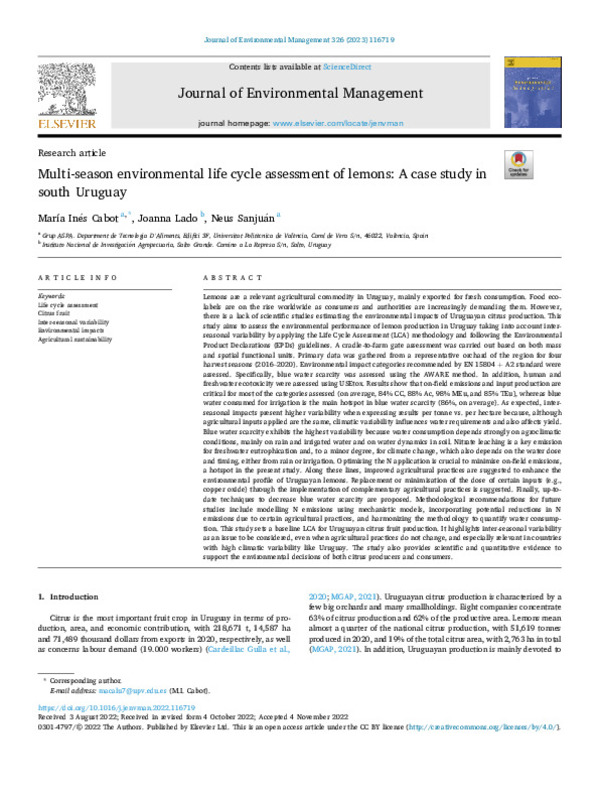JavaScript is disabled for your browser. Some features of this site may not work without it.
Buscar en RiuNet
Listar
Mi cuenta
Estadísticas
Ayuda RiuNet
Admin. UPV
Multi-season environmental life cycle assessment of lemons: A case study in south Uruguay
Mostrar el registro sencillo del ítem
Ficheros en el ítem
| dc.contributor.author | Cabot, María Inés
|
es_ES |
| dc.contributor.author | Lado, Joanna
|
es_ES |
| dc.contributor.author | Sanjuán Pellicer, María Nieves
|
es_ES |
| dc.date.accessioned | 2024-02-07T19:02:09Z | |
| dc.date.available | 2024-02-07T19:02:09Z | |
| dc.date.issued | 2023-01-15 | es_ES |
| dc.identifier.issn | 0301-4797 | es_ES |
| dc.identifier.uri | http://hdl.handle.net/10251/202395 | |
| dc.description.abstract | [EN] Lemons are a relevant agricultural commodity in Uruguay, mainly exported for fresh consumption. Food ecolabels are on the rise worldwide as consumers and authorities are increasingly demanding them. However, there is a lack of scientific studies estimating the environmental impacts of Uruguayan citrus production. This study aims to assess the environmental performance of lemon production in Uruguay taking into account interseasonal variability by applying the Life Cycle Assessment (LCA) methodology and following the Environmental Product Declarations (EPDs) guidelines. A cradle-to-farm gate assessment was carried out based on both mass and spatial functional units. Primary data was gathered from a representative orchard of the region for four harvest seasons (2016¿2020). Environmental impact categories recommended by EN 15804 + A2 standard were assessed. Specifically, blue water scarcity was assessed using the AWARE method. In addition, human and freshwater ecotoxicity were assessed using USEtox. Results show that on-field emissions and input production are critical for most of the categories assessed (on average, 84% CC, 88% Ac, 98% MEu, and 85% TEu), whereas blue water consumed for irrigation is the main hotspot in blue water scarcity (86%, on average). As expected, interseasonal impacts present higher variability when expressing results per tonne vs. per hectare because, although agricultural inputs applied are the same, climatic variability influences water requirements and also affects yield. Blue water scarcity exhibits the highest variability because water consumption depends strongly on agroclimatic conditions, mainly on rain and irrigated water and on water dynamics in soil. Nitrate leaching is a key emission for freshwater eutrophication and, to a minor degree, for climate change, which also depends on the water dose and timing, either from rain or irrigation. Optimising the N application is crucial to minimise on-field emissions, a hotspot in the present study. Along these lines, improved agricultural practices are suggested to enhance the environmental profile of Uruguayan lemons. Replacement or minimisation of the dose of certain inputs (e.g., copper oxide) through the implementation of complementary agricultural practices is suggested. Finally, up-todate techniques to decrease blue water scarcity are proposed. Methodological recommendations for future studies include modelling N emissions using mechanistic models, incorporating potential reductions in N emissions due to certain agricultural practices, and harmonizing the methodology to quantify water consumption. This study sets a baseline LCA for Uruguayan citrus fruit production. It highlights inter-seasonal variability as an issue to be considered, even when agricultural practices do not change, and especially relevant in countries with high climatic variability like Uruguay. The study also provides scientific and quantitative evidence to support the environmental decisions of both citrus producers and consumers. | es_ES |
| dc.description.sponsorship | Maria Inés Cabot is the recipient of a PhD scholarship (POS_EXT_2018_1_154319) from the National Agency for Research and Innovation (ANII, Uruguay). The authors particularly acknowledge UPEFRUY-Uruguay fruits (http://uruguayfruits.com.uy/en) for their sincere collaboration and for sharing their data for this study. The authors also especially acknowledge Dr. Matías Manzi from the Soil Fertility group, Soil and Water Department, at the Estacion ¿ Experimental de Facultad de Agronomía, Salto, Uruguay, for his suggestions and recommendations to improve the manuscript. | es_ES |
| dc.language | Inglés | es_ES |
| dc.publisher | Elsevier | es_ES |
| dc.relation.ispartof | Journal of Environmental Management | es_ES |
| dc.rights | Reconocimiento (by) | es_ES |
| dc.subject | Life cycle assessment | es_ES |
| dc.subject | Citrus fruit | es_ES |
| dc.subject | Inter-seasonal variability | es_ES |
| dc.subject | Environmental impacts | es_ES |
| dc.subject | Agricultural sustainability | es_ES |
| dc.subject.classification | TECNOLOGIA DE ALIMENTOS | es_ES |
| dc.title | Multi-season environmental life cycle assessment of lemons: A case study in south Uruguay | es_ES |
| dc.type | Artículo | es_ES |
| dc.identifier.doi | 10.1016/j.jenvman.2022.116719 | es_ES |
| dc.relation.projectID | info:eu-repo/grantAgreement/ANII//POS_EXT_2018_1_154319/ | es_ES |
| dc.rights.accessRights | Abierto | es_ES |
| dc.contributor.affiliation | Universitat Politècnica de València. Escuela Técnica Superior de Ingeniería Agronómica y del Medio Natural - Escola Tècnica Superior d'Enginyeria Agronòmica i del Medi Natural | es_ES |
| dc.description.bibliographicCitation | Cabot, MI.; Lado, J.; Sanjuán Pellicer, MN. (2023). Multi-season environmental life cycle assessment of lemons: A case study in south Uruguay. Journal of Environmental Management. 326. https://doi.org/10.1016/j.jenvman.2022.116719 | es_ES |
| dc.description.accrualMethod | S | es_ES |
| dc.relation.publisherversion | https://doi.org/10.1016/j.jenvman.2022.116719 | es_ES |
| dc.type.version | info:eu-repo/semantics/publishedVersion | es_ES |
| dc.description.volume | 326 | es_ES |
| dc.identifier.pmid | 36372036 | es_ES |
| dc.relation.pasarela | S\476510 | es_ES |
| dc.contributor.funder | Agencia Nacional de Investigación e Innovación, Uruguay | es_ES |
| dc.contributor.funder | Universitat Politècnica de València | |
| dc.subject.ods | 12.- Garantizar las pautas de consumo y de producción sostenibles | es_ES |








